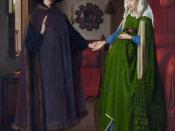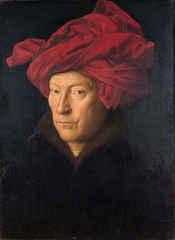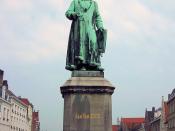Let's start with the pretty obvious images in van Eyck's Giovanni Arnolfini and His Bride. Two people, a man and a woman dressed in silks and fur, are standing next to each other in a bedroom. They are holding hands and look out at the viewer. Above the mirror on the back wall is a handwritten Latin inscription that translates "Jan van Eyck was here."
Despite the restricted space, many domestic objects are represented in the painting which probably also have traditional symbolic value. The little dog stands for fidelity and love. The broom hanging on the bedpost refers to cleanliness and purity. The fruit on the windowsill refers to the innocence of Adam and Eve before the fall--if they're apples specifically, they could represent the temptation of knowledge and the Fall itself. The burning candle in the chandelier can be interpreted as the nuptial flame, or as the eye of God.
The bed, with its bright red curtains evokes the physical act of love which, according to the religious beliefs of the moment, is an essential part of the perfect union of man and wife. Finally, the focal point of the whole composition the mirror. There can be seen two tiny figures reflected crossing the threshold of the room. These figures are a man in a red turban (thought to be van Eyck's image of himself) and a young man, both probably arriving to witness the marriage. An interesting aspect of this mirror is that it is curved in such a way that it is able to reflect both the floor and ceiling of the room, as well as the sky and garden outside, both of which are hardly visible through the room's actual window. The small medallions set into the mirror's frame show tiny scenes from the...


